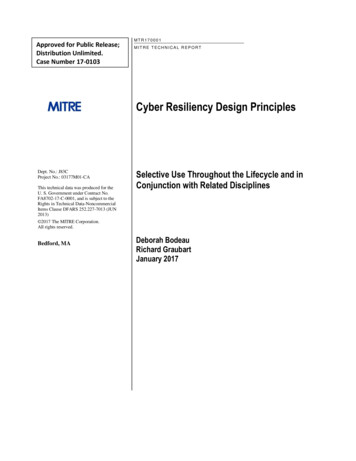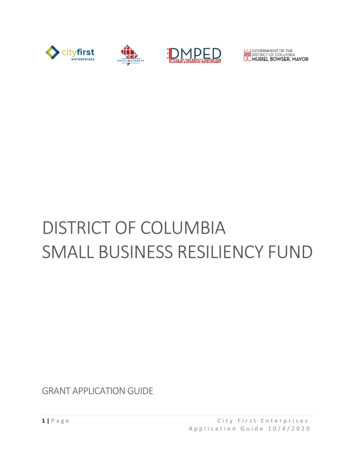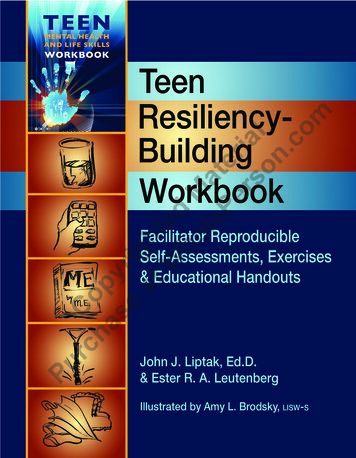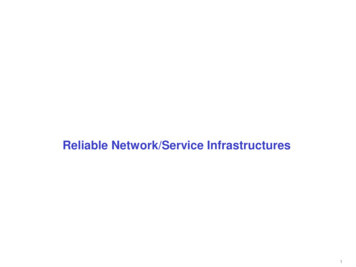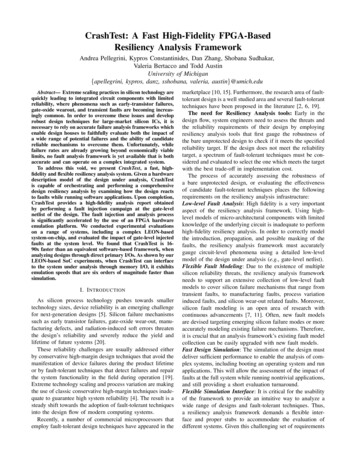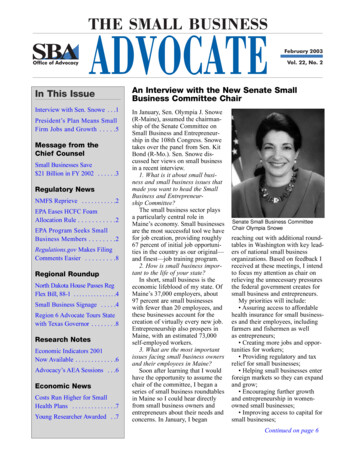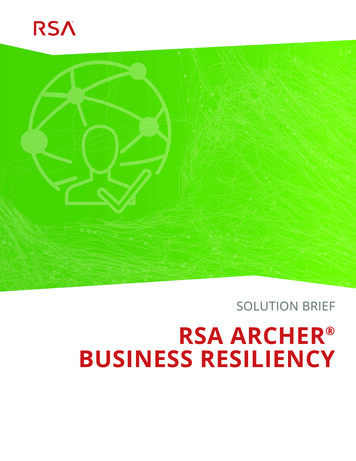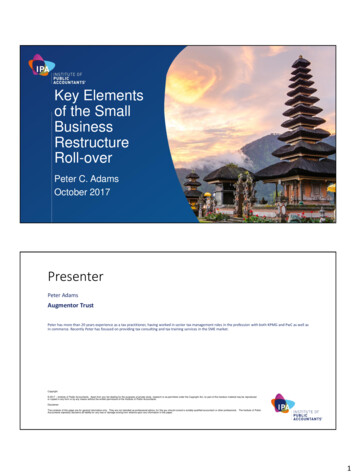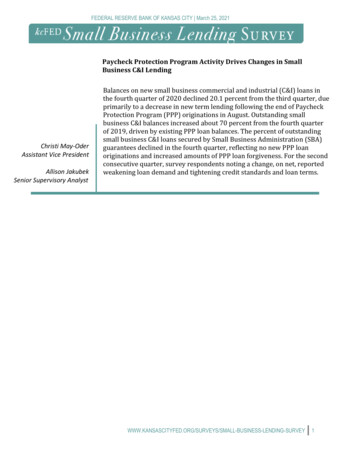
Transcription
SMALL BUSINESSRESILIENCY GUIDEKEEPING THE LIGHTS ON
A Note from America’s SBDCDear Small Business Owner,Most entrepreneurs know that a well-conceived business plan is critical to the success of a newbusiness. It should be just as clear that a business resiliency plan will be critical to the sustainability andsuccess of your business. Every business will face an unexpected disruption at some point. The planningyou do now can mean the difference in how quickly—or whether—your business recovers.This Business Resiliency Guide, and the two complementing workbooks found on our website, are toolsto help you assess risks and make contingency plans that can help your business recover from theimmediate threat as well as the disruptions that could continue over weeks or months.Since its inception in 1979 the SBDC network has grown from a few centers in 6 states to a nationwidenetwork of nearly 1,000 centers in all 50 states, the District of Columbia, Puerto Rico, American Samoa,Guam and the Marianas. In these 40 years SBDCs have also supported small business in ways beyondbusiness development. SBDCs are key partners in disaster recovery, working with SBA, FEMA, and Stateagencies to improve resiliency and speed recovery in disaster-stricken communities. Whether it isflooding, hurricanes, earthquakes or wildfires you will find SBDCs staffing the Business Recovery Centersand re- establishing communities. In addition, you’ll find SBDCs helping with cybersecurity, hosting ruraldevelopment conferences, and teaching opioid awareness. All the things that make SBDCs the leader insmall business assistance.If you need assistance with this or any other small business challenges, I encourage you to contact yourlocal SBDC using our search by zip code or state tool www.AmericasSBDC.org/find-your-SBDC. Thanks tosupport from federal and local funding partners, SBDCs around the country can provide customized andconfidential advice at no direct cost to your business.America’s SBDCs’ know that your business is your livelihood and we want to do everything possible tohelp ensure you have the tools and information you need to succeed.Sincerely,Charles “Tee” RowePresident & CEOAmerica’s SBDC1www.AmericasSBDC.org/protect-your-business
Purpose?This guide is designed to be used with the Business Resiliency Plan (BRP) workbook, and theEmergency Procedures workbook, both of which can be found on the America’s SBDC The BRP will be the culmination of work you do throughout this guide. You should print outthe BRP from the above website, as well as the Emergency Procedures workbook, and havethem with you as you work through this guide. They contain full sized versions of the tablesintroduced in this guide, with space to fill out your emergency response plans.Small businesses across the country are all exposed to the threat of disasters and hazards like violentstorms, wildfires and extreme weather events. More likely than these scenarios, your business couldforfeit valuable data in a cyber-attack, be robbed, lose a major customer, or unexpectedly must operatewithout a key employee. Such disasters can occur with little or no warning. Being prepared can helpyour business limit the damage done and resumeoperations faster.According to the Institute for Business and Home Safety,up to 25% of businesses don’t reopen following a majordisaster. FEMA has this number at nearly 40%. No one likesto think about disasters or losing key employees.However, when these events do happen, preparedbusinesses are better off. The goal of this guide is not toscare you with doomsday scenarios, but rather provide anopportunity for you to strengthen your business.Both the federal and state governments recognize the necessity of disaster planning and have resourcesto help businesses prepare for and recover from disasters. Some planning is even required, as theOccupational Safety and Health Administration (OSHA) requires businesses to have written and oralemergency response plans. A framework for making your written plan can be found on the America’sSBDC website in a document called, ‘Emergency Procedures’.The purpose of this guide is to be the starting point of the planning process, and to get you, the smallbusiness owner, thinking about how to best prepare your business for any potential disaster. Thisguidebook is designed to help you evaluate your business’s goals and to plan how the fundamentals ofyour operations can be protected, maintained, and recovered when problems arise. It is difficult toprepare for every possible disaster, but the fundamentals presented in this guide can help you build asolid foundation for your business to stand on in case of a ss
Using This GuideThe Business Resiliency Guide is arranged to follow a four-phase process, as displayed in the graphicbelow. In each section, blank tables are provided for you to fill in information your businesses uniqueinformation. This will be the base for your Business Resiliency Plan. Since every business faces differentthreats, your plan will be different from the plans of other businesses. Not every business has the sameprobabilities of experiencing a flood, fire, long-term power outage, or other event that would cause adisruption of a company’s ability to conduct their normal course of business.To maximize the utility of this booklet, it is important that throughout the process you honestly considerwhere your business currently stands in its various emergency preparation efforts and where it isvulnerable in these efforts. This guide and the America’s SBDC website provide basic information, tools,emergency contacts, and other resources that will help you with the process of making a businessresiliency plan that is tailored to your business.Being prepared now will save you time and resources in the future1.IdentifyIdentify key resources, employees, business functions,goals and threats.2.PlanPlanning for the threats and impacts to the businessfunctions as identified in Phase 1.3.ImplementTake the necessary steps to implement the plan setforth in Phase 2.RecoverRecovering strategies to return to normal businessoperations. As well as resources from the Small BusinessAdministration.4.If you hit a stumbling block along the way, reach out to us at a local Office. To locate yourSBDC by state or zip code go to our website. www.AmericasSBDC.orgFill in your local office information below:Phone:Email:Website:Advisor’s Name:Advisor’s s
Phase 1: IdentifyWhy do This?A business needs to know what poses the greatest risks to their company, their criticalbusiness functions that need protection, and the resources needed to support thosefunctions. Once this information has been identified, then an effective resiliency plan canbe created.Business GoalsBefore anything else, let’s start by looking at your business’s goals and objectives. Whatare you looking to accomplish and improve upon with your business? Your goals likely give your businessits direction and motivation. This direction and motivation are what drives businesses to grow.Protecting your businesses ability to grow is just as important as keeping it operational.Write down some of these goals below; keep them in mind as you continue through this guide.What are your goals that drive your business forward?BUSINESS GOALS:GoalsE.g.Expand manufacturing operations by buying new machines, new software, and otect-your-business
Critical Business FunctionsCritical business functions are unique to each business, without them your business cannot continue tooperate. Some critical business functions are determined by what you need to keep your businessoperational. This is the starting point. You won’t accomplish your goals if you do not have a business toaccomplish them with! Some examples of critical business functions are machinery for production orPoint of Sale systems.Typically, these functions are:1) An irreplaceable asset2) Are most sensitive to downtime3) Fulfill legal or financial obligations4) Play a key role in maintaining your business’s market share and reputation5) Maintain cash flowOther critical business functions could be determined by what resources you need to meet yourcompany’s goals. Whatever your mission, you have critical business functions that make it possible.Maybe you listed above that you have a goal to increase your productivity, expand your customer base,or add additional locations.You may also want to identify the resources that allow your critical functions to operate. Theseresources should have backups, so in the case of an emergency your business can continue to operate assmoothly as possible. Backup resources should be readily available and stored in a place where theywould be unaffected by the same situations that could affect your primary resources. In some cases,backing up a resource can be too costly, or simply not feasible. In these situations where you have nobackup resource, it is important to plan how to get that resource up and running quickly following adisruption. This will help limit downtime and the impact of a disruption your business.In the worksheet provided on the following page (example below) take the time to identify your criticalbusiness functions and the resources they use. There is section at the bottom of the table on the nextpage for you to make notes on any irreplaceable resources. We will address the impact of losing acritical function or supporting resource on page 12.Below is an example of what should go into the next page’s ce(s)EmployeeMachinery ion ofResourceBackupResource(s)Employee hasspecialized training touse the machineAllows us to run themachineAllows processing oforders, tells how muchour production shouldbeTrained 2 extraemployees in casehe/she gets sick or leavesBackup generatorCertain employees canwork from home withinternet, our backuplocation has internet too5www.AmericasSBDC.org/protect-your-business
CRITICAL BUSINESS FUNCTIONS & ce(s)Function ofResourceBackupResource(s)Sometimes there is no backup resource you can use. What other steps can you take to limit problems ordowntime when a critical business function does not operate as it should? E.g. if a key machine stopsworking, you could have a backlog of side projects already prepared for employees to work on until themachine is fixed. Perhaps an earlier model is in storage that, although it may operate at a lower productionrate, it can be used until the primary machine is operating again.*additional templates for this, and other tables shown in this guide, can be found on the BusinessResiliency webpage at ricasSBDC.org/protect-your-business
HazardsEmergencies and disasters, no matter how big or small, have the potential to disrupt critical businessfunctions. If these functions come to a halt, your business will be unable to work properly, affecting itsability to assist customers, turn a profit, and can jeopardize the success of the business. This makesplanning ways to limit the negative impact on a critical function’s downtime crucial.Identifying potential hazards to critical functions, along with assessing the severity and likeliness ofthose hazards, is the most important aspect of preparing for emergencies. Examples of potential hazardsare an earthquake destroying your storefront, a wildfire damaging the supply chain, the death of a keymanager, or a break-in.Examples of Hazards:-Fires-Wildfires-Floods-Earthquakes-Power Outage-Lack of Access-Landslides and Debris Flow-Hurricanes-Thunderstorms and Lightning-Tornadoes-Volcanoes-Tsunamis-Extreme Heat-Winter Storms and Extreme Cold-Medical Emergency-Supplier/Distributor Failure-Cyber Attack-Loss of Key Employee-Robbery-Civil Disturbance-Dam break-Drought-Transportation Accident-Infrastructure Failure-Arson-Bomb Threat-Workplace Violence-Active Shooter-Pandemic-Blockage of Supply Chain (ex. mountainpass closed)-Hazardous Materials Incidents-Household Chemical Emergencies-Nuclear Power Plant Emergencies-Biological Threats-Chemical Threats-Nuclear Threats-Nuclear Blasts-Radiological ur-business
Impacts from natural disasters are highly dependent on location. Researching commondisasters in your businesses’ region is the first step to pinpointing what emergencies are probable.Online, at the America’s SBDC website, resources for various natural and non-environmental disasterscan be found. As this booklet is general in nature, it cannot go in depth for each type of possibleincident, but simply helps start the brainstorming process for probable emergencies. Some emergenciesare harder to prepare for but acknowledging them and what effects they could have on your businesscan set a foundation to build on.What are some of the hazards that your business faces?The table on the next page is for identifying the different types of hazards your business faces. You canuse the scales below to rate how likely a hazard is to occur, and how severe it would be. These numberscan then be used along with the risk matrix on the following page to determine which hazards yourbusiness is most exposed to. This can help you prioritize which threats to focus your limited resourceson.-Rare: Highly unlikely, but it may occur under exceptional circumstances. Less than once every 10 years.-Unlikely: Not expected, but it could occur. There are no recent incidents. Has little means of occurring. Less thanonce every 2 years.-Possible: Should occur at some time, but very infrequent. Has some reason or means of occurring. Less than twiceper year.-Likely: This will probably happen. There is a history of regular occurrences. It has considerable means of occurring.2 to 5 times per year.-Almost Certain: Very Likely. The event is expected to occur as there is a history of regular occurrences. Strongmeans of occurring. More than 5 times per year.-Insignificant-Minor-ModerateEmployeeSafetyNo or only minorpersonal injury;First Aid needed butno days lostBusinessInterruptionNegligible; criticalfunctionsunavailable for lessthan an hourReputation &ImageNegligible impactBusinessobjectivesResolved in day-today managementMinor injury;medical treatment& some days lostInconvenient;Critical functionsunavailable forseveral hoursAdverse local mediacoverage onlyMinor impactInjury; Possiblehospitalization &numerous days lostClientdissatisfaction,Critical functionsunavailable for lessthan 1 dayAdverse city mediacoverageSignificant impact8www.AmericasSBDC.org/protect-your-business
-Major-CriticalSerious Injury &/orlong-term illnessCritical functionsunavailable for oneday or a series ofprolonged outagesAdverse andextended nationalmedia coverageMajor impactFatality(s) orpermanentdisability or illhealthCritical functionsunavailable formore than a day (ata crucial time)Demand forgovernment inquiryDisastrous impact-Minor: Acceptable, Unlikely to require specific application ofresources, manage by routine procedures. Monitor and review.-Moderate: Acceptable, Unlikely to cause damage and/orthreaten efficiency. Manage by specific monitoring and responseplans-Major: Generally, not acceptable, likely to cause some damageor breach of controls. Management attention needed andmanagement responsibility specified. Response plans need to bedeveloped.-Critical: Not acceptable, Likely to threaten the survival orcontinued effective functioning of the business. Immediateaction required. Need a response NOTESNeed to be ready for this one. Wildfiresare possible in our area and very ness
What are some of the risks that your suppliers and distributors face?Depending on the location of suppliers and distribution centers, natural disasters could disrupt parts ofyour supply chain. Recognizing risks for supplying regions is equally important as identifying your ownrisks. How will your business get resources if your supply chain is compromised? What is your backupmethod of distribution? The first table below is for you to identify hazards for your suppliers anddistributors, just like you did above for your own business. The second table below is for you to identifyyour backup suppliers and distributors. (Larger versions of these tables can be found in the BusinessResiliency Plan)ResourcesSuppliedSupplierNameSupplier 1, CaliforniaWidget PiecesDistributorNameProductDistributedThreatsThey FaceEarthquakeTsunamiWildfireThreatsThey ackup Suppliers:Company Name:Address:Phone:Fax:Contact Name:E-mail:Account Number:Materials/Service Provided:Backup Distributors:Company Name:Address:Phone:Fax:Contact Name:E-mail:Account Number:Materials/Service ess
Phase 2: PlanTime to PlanIn Phase 1 you identified the goals of your business, critical business functions that enable those goals,and the hazards your business & supply chain is susceptible to. The next phase is to plan for when thosehazards become a reality.In order to create a business resiliency plan, a business impact analysis must be done. This analysis candetermine the potential impacts of a disruption on your critical functions. Then we will walk you throughemergency procedures, an emergency communications plan, and a business continuity plan. This is acrucial section, as thoughtful and careful planning can determine how well your business responds in adisaster.Business Impact AnalysisThe business impact analysis (BIA) is based on the risks you identified in Phase 1. It predictsconsequences of the disruption of a business function, which provides a starting place for makingrecovery strategies. Part of the BIA is identifying impacts that result from disruptions. Impacts could befinancially harming, hinder operations, hurt brand image, or sever your customer base.Examples of impacts could be:-Lost sales, income or employeesRegulatory finesIncreased expensesCustomer dissatisfactionLoss of dataDowntimeDamages to buildings, machinery, or inventoryTime plays a major role in how a disruption can impact the business. A shortdisruption could have no noticeable difference in business operations, but a longer disruption, or onethat requires a longer-term recovery could have sizable impacts. This is incorporated into the businessimpact analysis as the recovery time objective. It is the point in time when a critical business function orprocess must be recovered before unacceptable consequences begin to occur.An example of a hazard is power outages, which are not an uncommon occurrence. Power outagesoccur during winter storms, windstorms, and even on a sunny day when you least expect it. What is theimpact of such an incident? Depending on the type of business, a problem with electricity or otherutilities could stop production, stall customer service, and/or halt a business function that requires theinternet, etc. In this example, we determined there is an estimated financial impact of up to 7,000 ifthe power were to go out for one day. What would a power outage do to your business for a day? For aweek? An example of what this impact would look like, when included in your plan, is on the next page.If an unexpected hazard occurs, do you feel confident that your business will be able to respond if acritical function is affected? Using the table on the following page, you can list the hazards that youidentified earlier on page 9. Possibilities could be a cyber-attack, the loss of a main supplier or ess
or a major equipment malfunction, etc. (refer to the hazards you listedin phase one) Next, determine which critical business functions wouldbe impacted, the recovery time objective, and the effect on both youroperations and finances.Hint: The Financial Impacts include both the money you need to pay tosolve the problem, the money you would have made had the problemsnever occurred, and the money you pay for your employees to be idle.For example, a fire could cause damage to your store front beyondwhat your insurance covers. Beyond just the cost it would take to fixyour storefront there are other costs. The revenue you could havegenerated had your store not been damaged is a cost.It is important to rememberdisasters could have multipleeffects. For example, anearthquake could affect sewagesystems, knock out power citywide, or affect the supply chainby damaging roadways. Awinter storm could closemountain passes, makinginbound or outbound shippingdifficult.BUSINESS IMPACT alImpactsFinancialImpactsProductionMachinery1 dayProduction halted 1,000(1 day) 5,000(1 week)CommunicationComputerSystems andPhones1 dayCannot takeorders or contactcustomers 500(1 day) 2000(1 iness
Emergency Response PlansYour emergency response plan is a set of objectives your business can use to combat the hazards youlisted on the previous page in your business impact analysis. It is strategic plan of what your organizationwill do. Emergency response plans will be composition of procedures that are unique to your business.Two of these procedures could be a communications plan and a business continuity plan. Explanationsof these two procedures as well as employee emergency procedures can be found on the followingpages.You will likely want an emergency response plan for the hazards you are most exposed to, as youidentified on page 9. An example for wildfires is given below. This is just an example; your emergencyresponse plans should be tailored to your business. A blank template for making emergency responseplans can be found at the end of the Business Resiliency Plan. The America’s SBDC website has resourcesthat can help you form your plans.Wildfire Emergency Response PlanXYZ CompanyLast Updated: July 7, 20XXNext update: January 7, 20XXPerson responsible for this plan: John DoePreparation:1) Take pictures of rooms, areas, and equipment that could sustain damage.This will be for insurance purposes. Have these pictures stored digitally andas a hard copy so that we don’t lose them in a fire. Update these pictures asneeded.Completed by John Doe on July 7, 20XXPerson Responsible:John Doe2) Make our business’s surrounding area defensible against fires. It shouldfollow the guidelines posted /Completed by Samantha Doe on July 7, 20XXSamantha Doe3) Determine which direction wildfire is most likely to come from. Make surewe are especially prepared for defense in that direction.Completed by Samantha Doe on July 7, 20XXSamantha DoeAction1. Initiate our Communications Plan to let employees and others know about on coming wildfireand possible disturbances to business activity.2. Initiate our emergency procedure for fires if we are in work hours.3. Initiate our business continuity plan after the wildfire has safely passed.4. Determine steps to recover to regular operations based on impacts of the ess
Emergency ProceduresEmergency procedures are needed so employees know what they shouldEmergency Proceduresdo if an emergency were to take place during work hours. Emergencyshould be postedprocedures could be for fires, high winds, earthquakes, chemical spills, ansomewhere in theactive shooter or terrorist act. Below is a checklist that you can use to seeoffice, wherewhat plans you already have created. This is not an exhaustive list, butemployees can easilyrather meant to get the ball rolling. If you already have emergencyfind them.procedures, this would be a good opportunity to look through them andmake sure they are up to date. An emergency procedure is typicallydesigned to be a step by step guide that every employee can easily follow when they are facedwith an emergency. The America’s SBDC website has resources thatcan help you make your procedures, as well as a booklet of exampleprocedures.Emergency Communication PlanIn the event of any emergency a communication plan is critical for coordinating between employees,distributors, customers and other important business personnel. An emergency communication planshould communicate to all your business’s contacts to answer their specific questions, preserve theimage of the business, and coordinate any business operations during and post-incident.The plan should effectively reach all contacts and tailor each message to the specific need of thataudience. A customer may want to know something different than the government or emergencypersonnel. Be prepared to answer how the incident or emergency will affect each contact. For thecommunications plan to stay useful, up-to-date contact information is needed. An effectivecommunications plan should be able to communicate through several different channels.In the event of an emergency; cellular and internet service may bedown. Because of this, you may wish to consider distributing a hardcopy of your communication plan to your staff, thus ensuring your plancan still be carried out. Like emergency procedures, this hard copyshould be readily accessible to all employees. There should beemployees who are specifically responsible for this plan, so that in theevent of an emergency it is not forgotten.Tip: Social media accounts area good way of reaching alarge amount of people if theinternet is still ness
The communications plan should not only communicate to your employees, but to your broadercommunity which includes business partners, suppliers, and distributors, so that they feel confident inyour ability to handle the situation. What is your emergency communication plan? How will you contactyour customers, suppliers, distributors, etc.? Who oversees implementing this plan?NameRolePhone & AddressMethods of communication (Cell phone, social media, person-to-person)PersonMethodNotesResponsibleCell PhoneSamantha DoeWe will try to contact all the abovepeople at their cell phone numberIf they don’t respond we will leavea message.Person Responsible for this plan:Business Continuity PlanOnce you have conducted the business impact analysis, you have the necessary information to startworking on a business continuity plan. The business continuity plan is meant to smooth out the negativeimpacts of disruptions on business functions following a disaster, as you identified in the businessimpact analysis. In perfect execution, following a business continuity plan should allow you to respond ina manner that will minimize impact. The business continuity plan can provide a bridge between shortterm operations following a disaster and long-term recovery, as discussed on page 21.The business continuity plan starts with a section similar to the business impact analysis. You will fill inyour critical functions, the staff in charge, resources needed, and backup resources. Remember fromearlier that backup resources should be readily available and stored in a place where they would be15www.AmericasSBDC.org/protect-your-business
unaffected by the same situations that could affect your primary resources. In the example given backupraw materials are stored offsite in a storage facility. These resources should still be safe if there was afire that burned the primary raw materials.Backup resources could also be your already established secondary or tertiary source of materialsshould your primary source’s ability to ship product be compromised. Keep in mind that your primarysources’ other customers will also be scrambling to find alternate suppliers. By having an establishedbusiness relationship with already identified alternate suppliers may give you an edge over yourcompetitors.The second part of the continuity plan will be identifying a backup location to run your business if yourprimary offices are compromised. Just like your backup resources you will likely want this location to besomewhere that typically would not be impacted. If an earthquake hit your town and your backuplocation was close to your primary location, both could be compromised.The next part of the continuity plan will be copying down yourcommunication plan and backup suppliers/distributors. You shouldhave already done these charts in previous sections of this guide.The last step of the continuity plan will be filling in the ‘how to use’box. This will lay out your businesses step by step process forfollowing the business continuity plan.Below, and on the following page is an example Business ContinuityPlan. A blank version with space for you to fill out can be found onthe America’s SBDC website in the workbook titled BusinessResiliency Plan.Business Continuity PlanThese are the critical business functions we need to run our business:CriticalFunctionProduction ofWidgetsCommunicationRecoveryTimeObjective1 day1 hourStaffInChargeJerry ResourcesWidget MachineHave our old machinein our storage facilityHave enough materialsfor one week ofproduction stored instorage facilityWe can use cell phonesRaw MaterialsSamantha DoeLandline Phones098-765-4321Samanthadoe@xmail EmailIf internet is down, wecan call people16www.AmericasSBDC.org/protect-your-business
Business Continuity Plan (continued)This is our backup location we will use if our primary offices are compromised:Backup Location: XY HotelAddress: 123 4th Street Doe
Most entrepreneurs know that a well-conceived business plan is critical to the success of a new business. It should be just as clear that a business resiliency plan will be critical to the sustainability and . This guide is designed to be used with the Business Resiliency Plan (BRP) workbook, and the Em
